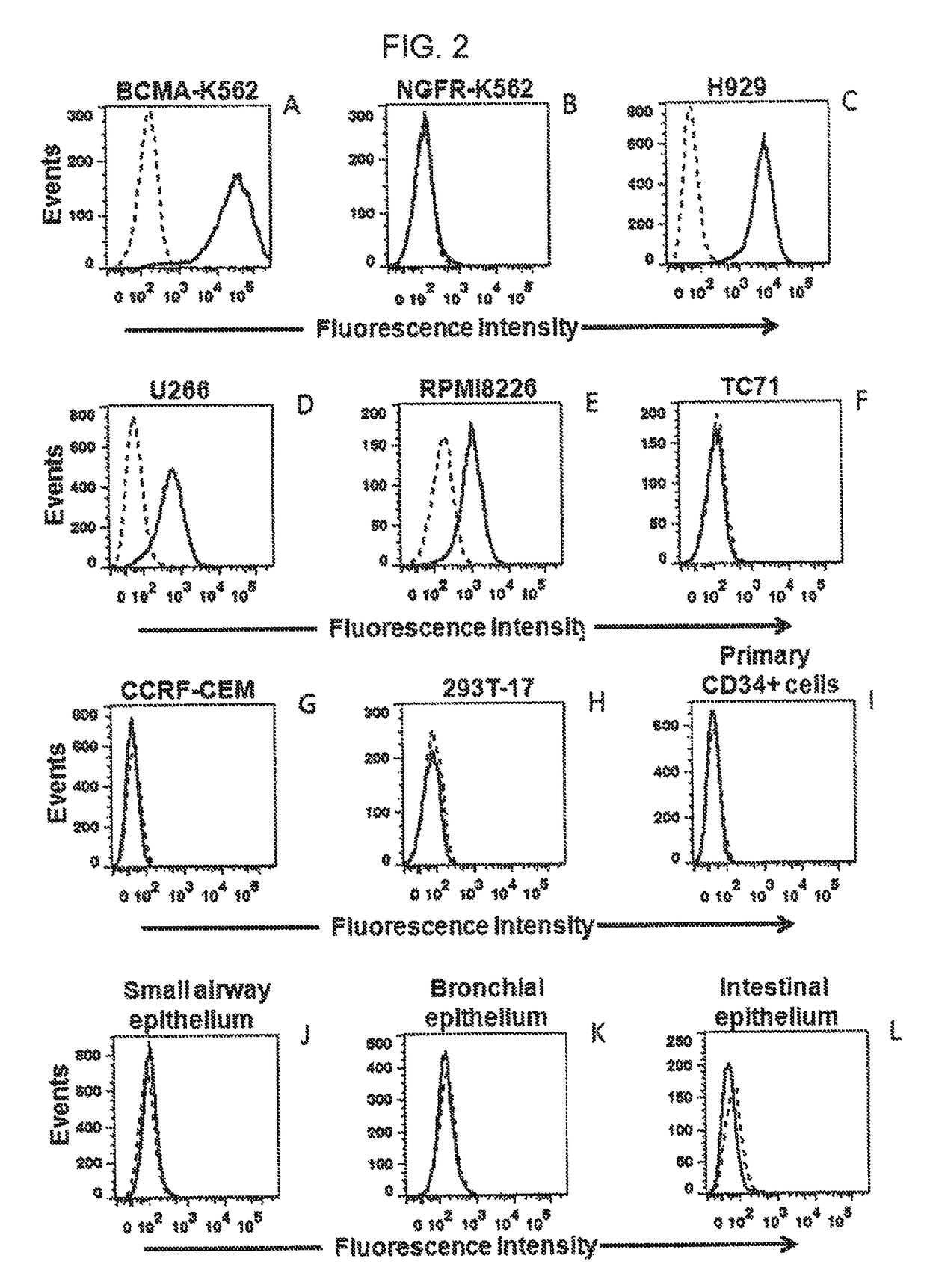Chimeric antigen receptors targeting B-cell maturation antigen
a technology of chimeric antigen and bcell, which is applied in the direction of antibody medical ingredients, immunoglobulins against hormones, drug compositions, etc., can solve the problems of high toxicity of this approach and few patients are cured
- Summary
- Abstract
- Description
- Claims
- Application Information
AI Technical Summary
Benefits of technology
Problems solved by technology
Method used
Image
Examples
example 1
[0081]This example demonstrates the expression pattern of BCMA in human cells.
[0082]Quantitative polymerase chain reaction (qPCR) was performed on a panel of cDNA samples from a wide range of normal tissues included in the Human Major Tissue qPCR panel II (Origine Technologies, Rockville, Md.) using a BCMA-specific primer and probe set (Life Technologies, Carlsbad, Calif.). cDNA from cells of a plasmacytoma that was resected from a patient with advanced multiple myeloma was analyzed as a positive control. RNA was extracted from the plasmacytoma cells with an RNeasy mini kit (Qiagen, Inc., Valencia, Calif.), and cDNA was synthesized using standard methods. A standard curve for the BCMA qPCR was created by diluting a plasmid that encoded the full-length BCMA cDNA (Origine Technologies, Rockville, Md.) in carrier DNA. The qPCR accurately detected copy numbers from 102 to 109 copies of BCMA per reaction. The number of β-actin cDNA copies in the same tissues was quantitated with a Taqman...
example 2
[0086]This example describes the construction of the inventive nucleic acid sequence encoding anti-BCMA chimeric antigen receptors (CARs).
[0087]Antibody sequences of two mouse-anti-human-BCMA antibodies designated as “C12A3.2” and “C11D5.3” were obtained from International Patent Application Publication WO 2010 / 104949 (Kalled et al.). The amino acid sequences of the heavy chain variable regions and light chain variable regions of these antibodies were used to design single chain variable fragments (scFvs) having the following general structure:
[0088]light chain variable region-linker-heavy chain variable region.
[0089]The linker had the following amino acid sequence: GSTSGSGKPGSGEGSTKG (SEQ ID NO: 7) (see, e.g., Cooper et al., Blood, 101(4): 1637-1644 (2003)).
[0090]DNA sequences encoding two chimeric antigen receptors were designed, each of which contained the following elements from 5′ to 3′: the CD8α signal sequence, the aforementioned anti-BCMA scFv, hinge and transmembrane region...
example 3
[0100]This example describes a series of experiments used to determine the specificity of the inventive CAR for BCMA.
Cells
[0101]NCI-H929, U266, and RPMI8226 are all BCMA+ multiple myeloma cell lines that were obtained from ATCC (ATCC Nos. CRL-9068, TIB-196, and CCL-155, respectively). A549 (ATCC No. CCL-185) is a BCMA-negative lung cancer cell line. TC71 is a BCMA-negative sarcoma cell line. CCRF-CEM is a BCMA-negative T-cell line (ATCC No. CCL-119). BCMA-K562 are K562 cells (ATCC No. CCL-243) that have been transduced with a nucleic acid sequence encoding full-length BCMA. NGFR-K562 are K562 cells that have been transduced with the gene encoding low-affinity nerve growth factor (see, e.g., Kochenderfer et al., J. Immunotherapy., 32(7):689-702 (2009)). Peripheral blood lymphocytes (PBL) from three patients with multiple myeloma (i.e., Myeloma Patient 1 through 3) were used, as were PBL from three other subjects: Donor A, Donor B, and Donor C. Donors A through C all had melanoma. CD3...
PUM
| Property | Measurement | Unit |
|---|---|---|
| concentration | aaaaa | aaaaa |
| concentration | aaaaa | aaaaa |
| length | aaaaa | aaaaa |
Abstract
Description
Claims
Application Information
 Login to View More
Login to View More - R&D
- Intellectual Property
- Life Sciences
- Materials
- Tech Scout
- Unparalleled Data Quality
- Higher Quality Content
- 60% Fewer Hallucinations
Browse by: Latest US Patents, China's latest patents, Technical Efficacy Thesaurus, Application Domain, Technology Topic, Popular Technical Reports.
© 2025 PatSnap. All rights reserved.Legal|Privacy policy|Modern Slavery Act Transparency Statement|Sitemap|About US| Contact US: help@patsnap.com



